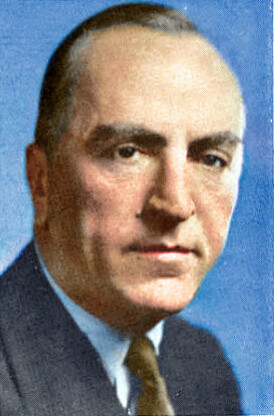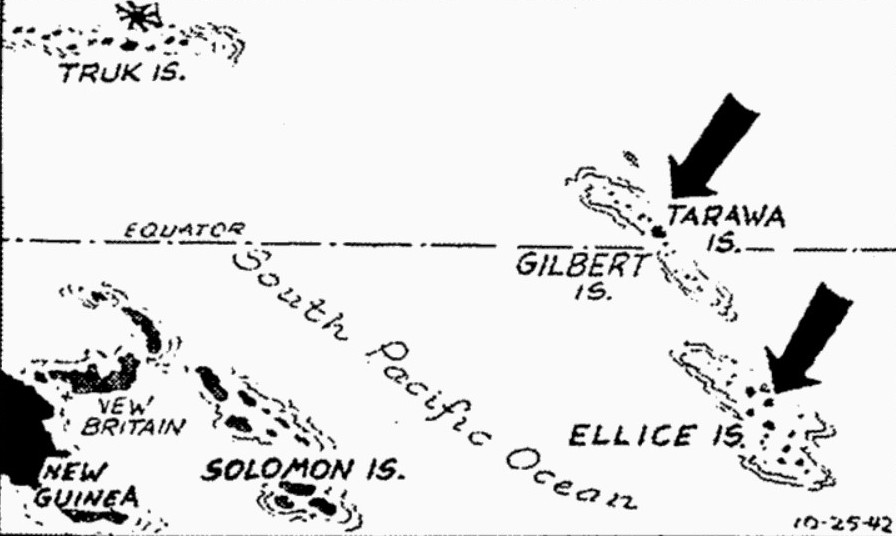RICKENBACKER LOST ON PACIFIC FLIGHT
Ace missing 3 days on secret mission
Wide area south of Hawaii searched for bomber, prospects ‘gloomy’
By Frank Tremaine, United Press staff writer

Capt. Eddie Rickenbacker. Will his luck hold out again?
Honolulu, Hawaii –
Army and Navy planes and surface vessels searched the sea south of the Hawaiian Islands today for Capt. E. V. (Eddie) Rickenbacker and the crew of a bombing plane which disappeared Wednesday evening.
At 2 p.m. EWT, Capt. Rickenbacker, the plane, and its crew had been missing 66 hours and authorities felt that prospects of finding them were “gloomy.”
But there was hope. In addition to the chance that the plane had made an emergency landing on one of the countless atolls in the Pacific and had been unable to establish radio contact, there was the possibility that all the men were adrift on the life raft with which the plane was equipped.
Planes sink quickly
Land planes forced down at sea sink almost at once, but the rafts, painted yellow so they can be spotted from the air, are easily launched. There have been cases since the war started of Navy pilots drifting on them for as long as a month before being rescued.
Though the fortitude of the greatest American ace of World War I is well known, he is now 52 years old and was seriously injured in an airplane crash near Atlanta, Georgia, in 1941, and authorities feared that he might not have the physical stamina to endure prolonged exposure to the blistering sun.
On special air mission
It was revealed in Washington last night that Capt. Rickenbacker, who is president of Eastern Airlines but is serving as confidential aviation adviser to Secretary of War Henry L. Stimson had been aboard a bombing plane of unspecified size but believed to have been a four-motored one, which disappeared while en route from Hawaii to “an island in the South Pacific.” He was on a special inspection trip on behalf of Lt. Gen. H. H. Arnold, commanding general of the Army Air Forces.
Washington reported that it was believed there Capt. Rickenbacker was en route to Australia.
The number of men with Rickenbacker was not known, but was believed to be 9 to 11.
Gas for only an hour
Late Wednesday afternoon, the plane reported that it had gasoline for one more hour of flight. Then nothing more was heard and because of that, it was feared it had been forced to make a crash landing at sea.
The plane disappeared in approximately the same region where Amelia Earhart Putnam disappeared in 1937, during the course of an around-the-world flight, never to be heard from again.
Capt. Rickenbacker only recently returned from Great Britain where he was on a mission similar to the one on which he was engaged when he disappeared.
His presence here had been a closely guarded secret known only to a few high military and civilian authorities. His friends here refused to believe he had perished, saying he had a faculty for pulling out of difficulties.
Capt. Rickenbacker flirted with death most of his life. He was an auto racing hero in the early days of the motorcar, a flying ace who took on seven German planes at one time by himself in World War I, an auto manufacturer and head of Eastern Airlines.
His narrowest escape from death was in the crash of one of his own company’s planes near Atlanta, Georgia, on Feb. 27, 1941.
Eight persons were killed; he suffered a broken hip and numerous other fractures, and lay pinned in the wreckage for hours before rescuers arrived. Despite his pain, he did what he could to make the other injured comfortable and kept them from lighting cigarettes that might have set the wreckage on fire and burned them all.
Toured air units
Although his health was not fully restored, he made a 14,000-mile flying trip around the country early this year at the request of Gen. Arnold, Chief of the Army Air Forces, to deliver talks to air combat units.
Before Pearl Harbor, he urged a stronger air force and said most Americans did not appreciate the global problems confronting the Allies.
Capt. Rickenbacker was born in Columbus, Ohio. He quit his first job, selling autos, to become a racing driver and won one of the early Indianapolis Memorial Day races.
Pershing’s chauffeur
He volunteered in the Signal Corps in 1917, but because he had no college education, found it difficult to get into flying school, until after he had served several months in France as Gen. John J. Pershing’s personal chauffeur. He was sent to the flying school at Issoudun.
Soon after he graduated, he became commander of the 94th Aero Squadron. His record, the best of any American flier, was shooting down 25 German planes.
He was awarded the Croix de Guerre, French Legion of Honor medal and the Congressional Medal of Honor for his attack upon seven German planes – five fighters and two bombers. He shot down one bomber and one fighter, and the rest fled.
Mother confident he’ll be found
Los Angeles, California (UP) –
Mrs. Elizabeth Rickenbacker, 79-year-old mother of Capt. Eddie Rickenbacker, today would not give up hope for her son who is missing somewhere in the Pacific.
Mrs. Rickenbacker was quoted as saying by the missing aviator’s brother, Dewey C. Rickenbacker:
Eddie had many narrow escapes from death and I am sure he will be found alive and well.
The brother reported that his mother was upset by the report but she expressed the firm belief to him that Capt. Rickenbacker would be found alive and well.
Dewey Rickenbacker said:
She’s as confident that he will pull through this as she was that he would live through that crash last year in Georgia when the doctors just about gave him up.
The brother disclosed that Capt. Rickenbacker visited them only last Sunday.
Mrs. Rickenbacker hopes for the best
New York (UP) –
Mrs. E. V. Rickenbacker sat by her telephone today, hoping for the best.
Friends called and tried to comfort her. Occasionally, she wept a little.
She said:
There is nothing I can do – nothing. That is what makes it hard. I just sit here and wait.
Lt. Gen. Henry Arnold telephoned her from Washington yesterday that her husband was missing.
She said:
Since then, I’ve just been sitting here, hoping he will call again to tell me all is well.
With forced jollity, she said:
Oh, I’m used to waiting for news that Eddie has arrived. He always has spent a lot of his time going places. He’s not reckless and he knows the air. And he always has said that he’s the darling of Lady Luck.
She and Eddie were married in 1922. They had two sons: David, 15, and William, 18, who are attending school in Asheville, North Carolina.


